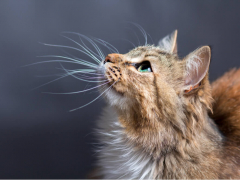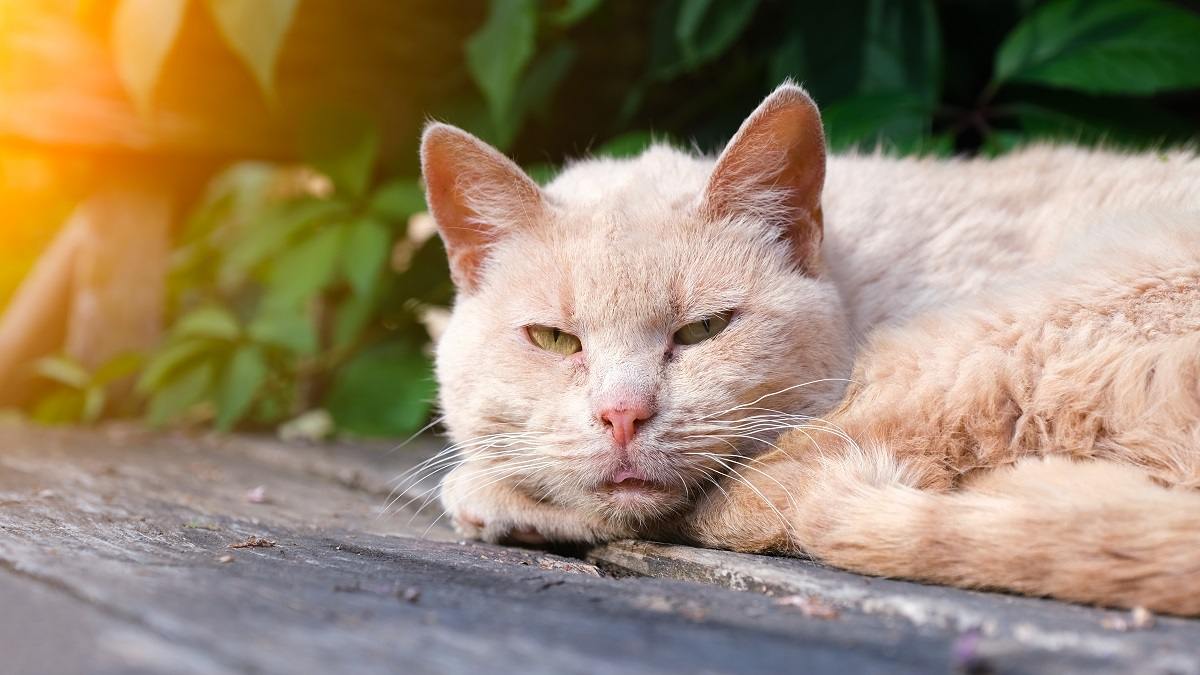
fokusgood / Shutterstock.com
Hyperadrenocorticism in cats, also known as hypercortisolism or Cushing’s disease, is a rare condition in cats. In this article, learn what causes hyperadrenocorticism, how it is diagnosed, treatment options, and some frequently asked questions.
What Is Hyperadrenocorticism in Cats?
Hyperadrenocorticism is commonly called Cushing’s disease. Although hyperadrenocorticism is considered a fairly common disorder in dogs, it is rarely seen in cats. According to one study published in 2014 that reviewed Cushing’s in cats, fewer than 100 cats with the disease were described in scientific medical journals.
Although rare in cats, it is very similar to the disease of the same name that occurs in dogs. The mean age at which cats are diagnosed is about 10 years of age.
Hyperadrenocorticism describes a disease where the adrenal glands located near the kidneys produce excesses of steroid hormones that circulate throughout the body. Excess steroid hormone can lead to several long-term effects on the body.
These effects can be similar to those that would be seen in a dog or cat on high doses of steroids for prolonged periods of time. However, when that occurs, it is called iatrogenic (illness related to medical treatment) hyperadrenocorticism.
Iatrogenic Cushing’s disease is also considered rare in cats, because cats have a higher tolerance for long-term steroid use than dogs do.
More specifically, the condition being discussed here is spontaneous hyperadrenocorticism, meaning the disease occurs because of changes originating in the cat’s body.
Causes of Hyperadrenocorticism in Cats
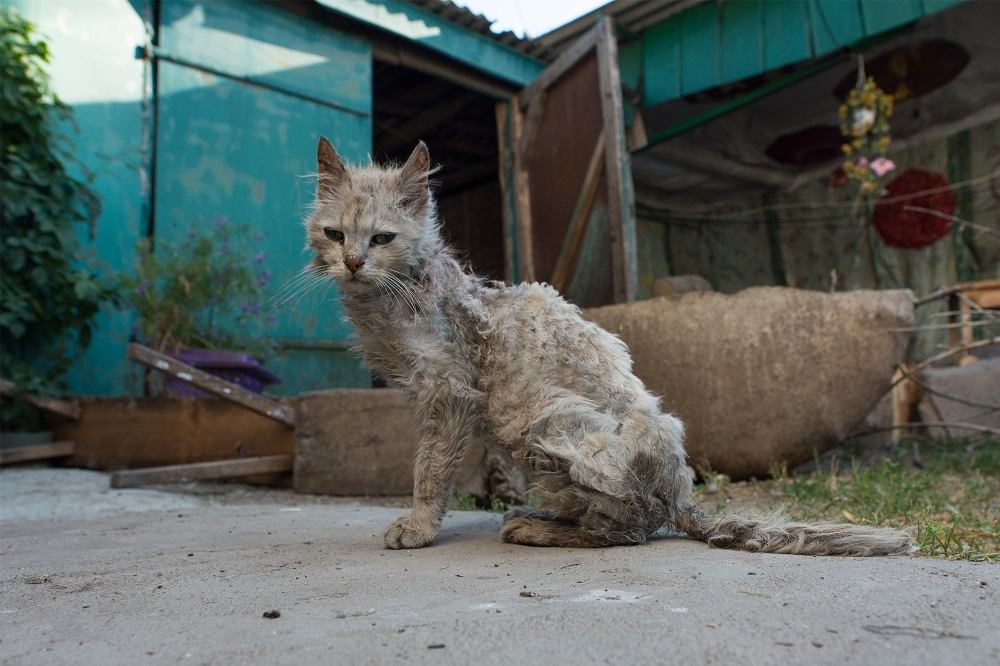
The primary cause of hyperadrenocorticism in cats, a pituitary tumor, can cause changes including weight loss and a poor quality haircoat. mylisa / Shutterstock.com
In cats, the most common cause of Cushing’s disease is what is called a functional pituitary tumor. This means the pituitary tumor is benign (not cancerous), but its presence contributes to an overactive adrenal gland.
The pituitary gland is a very tiny structure located near the center and bottom of the brain. It secretes several hormones critical to daily function. One of those hormones is called adrenocorticotropic hormone (ACTH), which is the hormone that stimulates the adrenal glands to produce steroid hormones.
With Cushing’s disease involving a pituitary tumor, the excessive amount of ACTH being produced causes both (in most cases) adrenal glands to enlarge in size and go into overdrive producing excess hormones. About 80% of cats develop this pituitary dependent form of Cushing’s disease.
Approximately 20% of cats with Cushing’s have an adrenal-dependent form. This means that instead of a tumor occurring in the pituitary gland, a tumor occurs only in one of the adrenal glands. About 50% to 80% of these cats can have a benign functional adrenal tumor with the remainder having a malignant (cancerous) tumor.
There is no known breed predisposition or risk factors that contribute to either form of Cushing’s disease in cats, though given how uncommon it is, a genetic predisposition might be one consideration.
Symptoms of Hyperadrenocorticism in Cats
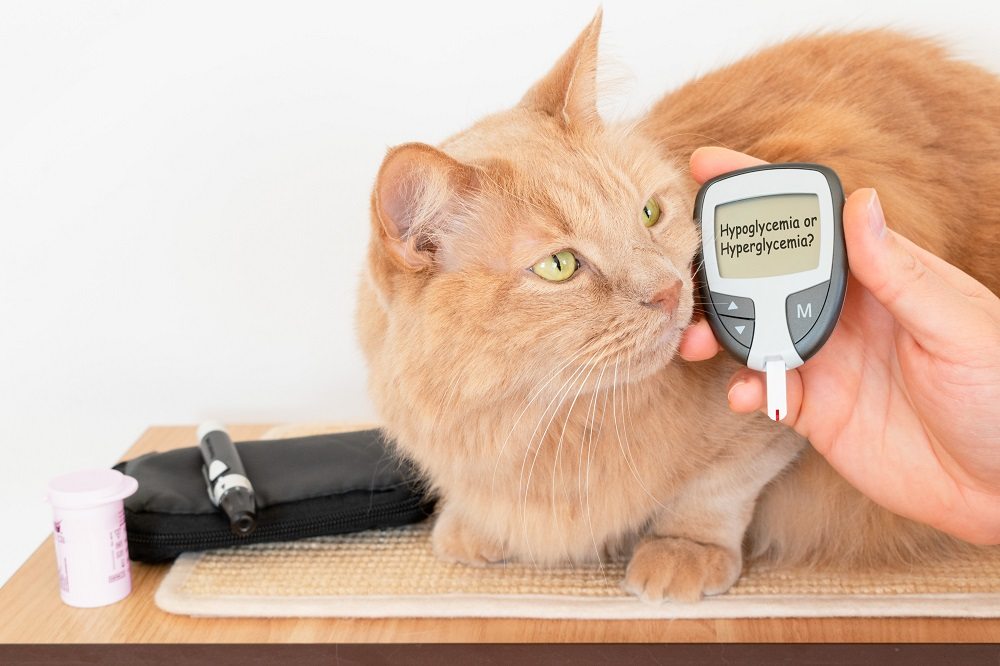
A large percentage of cats with hyperadrenocorticism also have diabetes mellitus and show many of the same signs of illness. Yaya Photos / Shutterstock.com
The most common symptoms cats show with Cushing’s disease are signs of diabetes mellitus. Very much unlike dogs, about 80 to 90% of cats with Cushing’s disease also have diabetes at the same time.
The reason that Cushing’s disease and diabetes happen together so often in cats is because cats almost exclusively get a form of diabetes like type 2 diabetes in people that develops from insulin resistance (as opposed to not enough insulin being produced by the pancreas as in type 1 diabetes).
With Cushing’s disease, the adrenal glands produce an excess of the steroid hormone cortisol, which contributes to insulin resistance. This is similar to the principle where having a cat on steroid medication for extended periods can carry risk for development of diabetes.
The signs most commonly seen in diabetic cats include:
- Increased thirst (polydipsia)
- Increased urination (polyuria)
- Increased appetite (polyphagia)
- Weight loss
- Lethargy
In addition to the signs seen with diabetes, further symptoms of Cushing’s disease in cats might include:
- Unkempt (matted) hair coat
- Thinning hair coat/hair loss (alopecia)
- Thin, fragile skin
- Skin that bruises easily
- Pot-bellied appearance
Complications of Hyperadrenocorticism in Cats
Complications of Cushing’s disease in cats, especially if it is not treated, are more related to complications of concurrent diabetes, which can include:
- Vomiting
- Weakness/collapse
- Increased risk for infections, especially of the urinary tract
The thin, fragile skin seen in cats with Cushing’s disease more specifically can lead to cuts or tears in the skin. This might be more obvious if an attempt is made to shave or cut off hair mats that are present.
Diagnosis of Hyperadrenocorticism in Cats
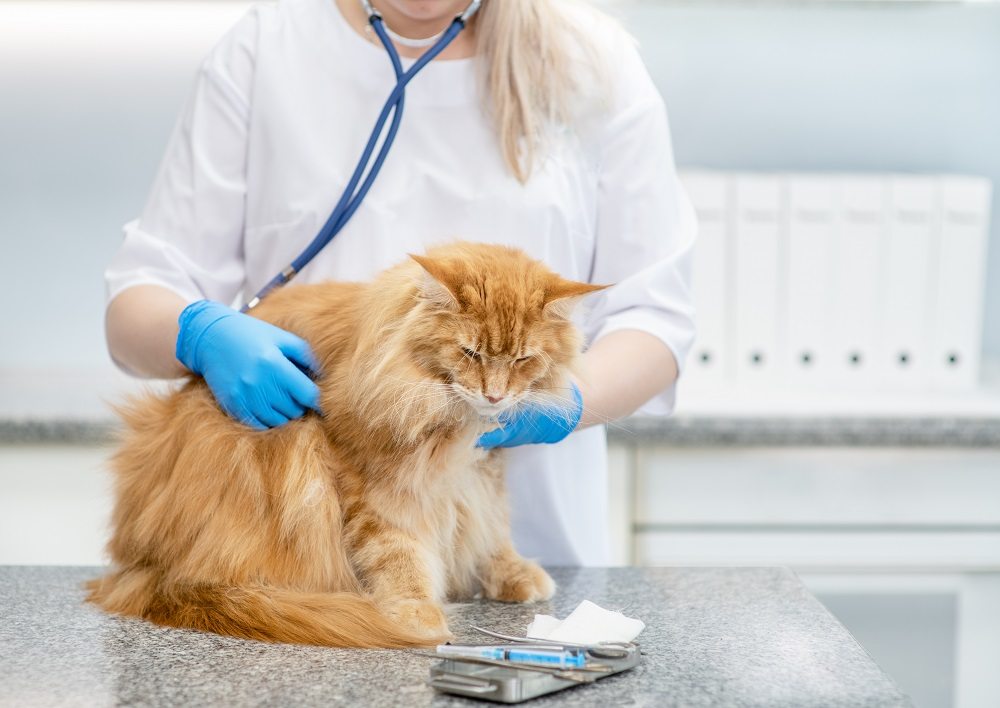
The first step of reaching a diagnosis of hyperadrenocorticism in cats is a visit and exam with a veterinarian. Ermolaev Alexander / Shutterstock.com
Because Cushing’s disease is considered rare in cats and most show very obvious signs of diabetes (which is very common in cats), veterinarians might not always suspect Cushing’s disease initially.
However, many veterinarians will suspect that Cushing’s disease is also present in a cat where diabetes is difficult to regulate with insulin injections (because of insulin resistance from Cushing’s).
The presence of more extensive skin problems in a diabetic cat might also be a clue that Cushing’s disease is present too.
On basic lab work, often no specific changes are seen that provide clues that Cushing’s disease is present. The alkaline phosphatase (ALP) enzyme elevation commonly seen in dogs and used to screen for Cushing’s does not elevate with the disease in cats.
There are a few testing methods used to arrive at a Cushing’s disease diagnosis.
Urine cortisol-creatinine ratio: This urine test compares levels of cortisol in the urine to levels of creatinine, a common waste product excreted by the kidneys. This test is only helpful if the ratio is low, as it makes Cushing’s disease very unlikely. If the value is high, then additional blood testing is needed.
Low-dose dexamethasone suppression test: This is the test of choice for diagnosing cats with hyperadrenocorticism. A low-dose injection of dexamethasone is administered and cortisol levels are checked four hours and eight hours later. Higher than normal cortisol values at both times or just at the eight-hour mark is supportive for Cushing’s disease.
Ultrasound: An ultrasound or sonogram is a minimally invasive way to view the adrenal glands themselves. For the most part, ultrasound will be used more after blood testing confirms the disease in order to help tell the difference between Cushing’s caused by a pituitary problem versus an adrenal problem.
If Cushing’s disease is already confirmed, ultrasound is used to look for symmetry of the glands. If they are both the same size, pituitary-dependent disease is present. If one gland is larger than the other, adrenal-dependent disease is present. This method of determining the type of Cushing’s has been found to be more than 90% accurate in cats.
Ultrasound may be used to diagnose disease if a single large adrenal tumor is found. But if both adrenal glands are affected, ultrasound is not reliable for diagnosis alone as there is no specific size of an adrenal gland that confirms Cushing’s disease. Even in cats with Cushing’s disease where both glands are affected, the glands themselves might actually measure normally.
The adrenocorticotropic hormone stimulation test (ACTH stim) is commonly performed in dogs, but it is not commonly performed in cats. About 60% of cats that actually have Cushing’s might still have a negative ACTH test result, making it an inaccurate one to use.
Magnetic resonance imaging (MRI) and computed tomography (CT or “CAT” scan): These are advanced techniques often used to image structures within the skull, like the pituitary gland. In cases where surgery or radiation therapy may be considered to address Cushing’s disease caused by a pituitary tumor, MRI and/or CT may be required.
Treatments for Hyperadrenocorticism in Cats
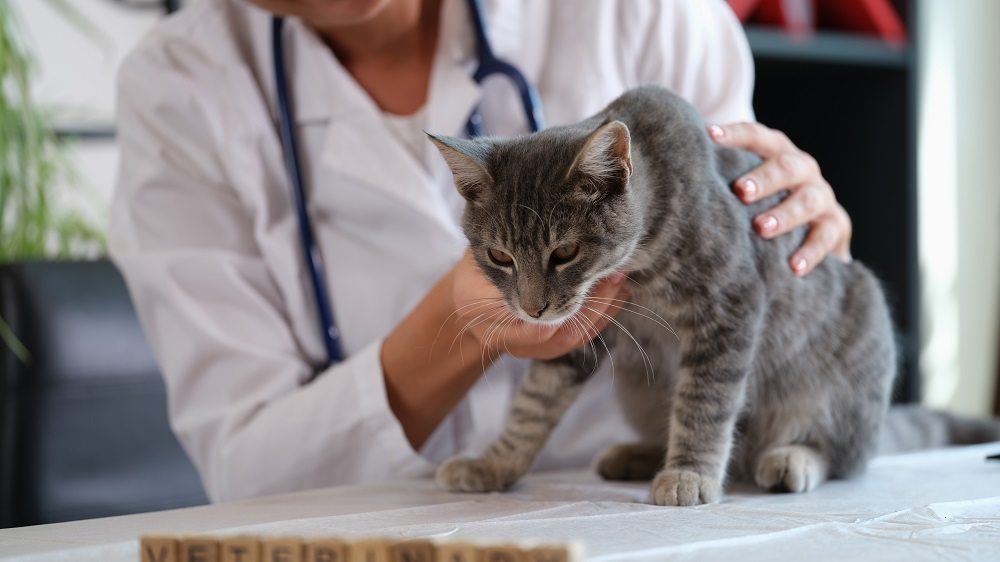
There are a few treatment approaches for hyperadrenocorticism. Your veterinarian can help decide the best place to start. megaflopp / Shutterstock.com
There are a few treatment approaches for Cushing’s disease in cats. They include medical, surgical, and radiation therapy.
1. Medical
The most successful medical treatment is with trilostane (Vetoryl). This is the same medication used to treat Cushing’s disease in dogs.
Trilostane is given two to three times a day. Once started, cortisol levels can be rechecked with the ACTH stimulation test. The main goals with treatment are improvement in quality of life for the cat and ensuring that cortisol levels don’t reverse and drop too low.
Other medications that have been used in dogs, including mitotane, selegiline, metyrapone, and even the antifungal agent ketoconazole (which can lower cortisol in people and dogs), either do not work well in cats or carry toxicity concerns.
2. Surgical
Surgery is most successful in cases of a single benign adrenal tumor. The abnormal adrenal gland can be removed (called an adrenalectomy), which is considered a cure in those cases.
Removal of the pituitary gland (hypophysectomy) is a potential surgical option in cases of pituitary-dependent Cushing’s disease. However, this procedure is challenging and complicated. There are only a few locations worldwide with veterinary surgeons trained to perform it.
When performed by a team of well-trained specialists, surgical removal of the pituitary gland can be successful with a potential for a cure.
With surgical approach to treatment with either adrenal dependent or pituitary dependent Cushing’s disease, medical management to stabilize the cat’s condition first might be necessary.
3. Radiation Therapy
Radiation therapy may be an option for treating a pituitary tumor. While it is unlikely to provide a cure, it can reduce pituitary tumor size by up to 50%. Radiation therapy has been associated with a reduced need for insulin in a majority of cats that also have diabetes, and many cats have been able to go into permanent diabetic remission.
4. Treatment Outcomes
The results of treating hyperadrenocorticism in cats is unfortunately highly variable. Even if a therapy approach successfully treats Cushing’s disease, the diabetic condition also found in most cats might not fully resolve and insulin therapy might still be required.
Cats with a functional (benign) adrenal tumor removed with surgery can be essentially cured. But when treating a pituitary tumor, complications and frustrations can be very common, especially with most cats also having difficult-to-control diabetes that also must be treated.
In one study, five out of nine cats had a positive response to trilostane lasting longer than one month. Some medically treated cats might have their insulin requirements reduced while others might not.
A median survival time of only 1 to 2 months might unfortunately be expected. This means that some cats might do a little better for longer while others will not even make it through the first month of treatment. Poor outcomes might largely be related to the complications of poorly controlled diabetes as well as severe skin disease that might ultimately take months to resolve.
The only cats that had their diabetes fully resolve in the above study had undergone radiation therapy. This does suggest that radiation therapy might be associated with better long-term outcomes. Radiation therapy is however far more expensive and less available in many areas.
Surgical removal of the pituitary gland is even less available (and more expensive) owing to it being a highly specialized procedure that few veterinary surgical specialists are trained to do. However, in time, this approach might gain more of a foothold if it becomes more available. It does present the only potential “cure” for a pituitary tumor.
The main complication for pituitary surgery is that cats that have the pituitary removed will require lifelong supplementation with oral steroids and thyroid hormone.
Cat Care Tips
- Most complications from hyperadrenocorticism in cats develop from poorly controlled diabetes.
- Make sure to follow your veterinarian’s instructions carefully for recheck testing (both for Cushing’s and for concurrent diabetes).
Preventing Hyperadrenocorticism in Cats
There is no specific way to prevent Cushing’s disease in cats. Because this disorder is considered so uncommon in cats, it has been difficult to develop risk factors. A genetic predisposition might exist in those cats that develop adrenal or pituitary tumors.
Frequently Asked Questions
What are signs of Cushing’s disease in a cat?
The most common signs of Cushing’s disease (hyperadrenocorticism) in a cat are actually signs of diabetes, which most cats with Cushing’s disease also have. These signs include an increased need to drink, urinate, and eat. Weight loss and lethargy are also common.
Other signs of Cushing’s disease include very poor coat quality, thin hair, fragile skin that bruises or cuts easily, and a pot-bellied appearance.
What does Cushing’s look like in cats?
Cats with Cushing’s disease might use the litter box more often and spend a lot more time at the water bowl. Appearing extra hungry is common.
A cat with Cushing’s might physically appear to have a distended belly while looking thinner over the back and spine. Hair coat might be thin and sparse.
What is the life expectancy of a cat with Cushing’s disease?
Prognosis for Cushing’s disease depends on the type and how bad complications are. If Cushing’s is caused by an adrenal tumor, surgical removal of the tumor might be curative. Prognosis from there depends on management of diabetes that might still remain.
But if Cushing’s disease is caused by a pituitary tumor, treatment can be more challenging. Because medical management can take time and response is variable, and because diabetes that occurs at the same time is very hard to manage, life expectancy for many cats might only be a couple of months.
Radiation therapy or pituitary gland surgery migt have better long-term outcomes, but they are both less affordable and less available.
Do cats get hyperadrenocorticism?
Cats do get hyperadrenocorticism (also called Cushing’s disease). The disease is similar to the one seen in dogs, but has some major differences. A majority of cats with Cushing’s disease will also have diabetes mellitus at the same time. Management in cats can also be more challenging, as some of the therapies used in dogs are not as effective in cats.
-
Boland, L. A., & Barrs, V. R. (2017). Peculiarities of feline hyperadrenocorticism: Update on diagnosis and treatment. Journal of Feline Medicine and Surgery, 19(9), 933–947. https://doi.org/10.1177/1098612x17723245
-
Chapman, P.S. Hyperadrenocorticism in Cats: Causes and Treatment. Blue Pearl Pet Hospital. Accessed October 12, 2023.
-
Feline Hyperadrenocorticism/Hypercortisolism. American Animal Hospital Association.
-
Greco, D.S. and Kritschevsky, J.E. Disorders of the Pituitary Gland in Cats. Merck Veterinary Manual Online. Reviewed/Revised August 2018. Modified October 2022.
-
Lien, Y., Huang, H., & Chang, P. (2006). Iatrogenic hyperadrenocorticism in 12 cats. The Journal of the American Animal Hospital Association/Journal of the American Animal Hospital Association, 42(6), 414–423.
-
Valentin, S., Cortright, C., Nelson, R., Pressler, B., Rosenberg, D., Moore, G., & Scott‐Moncrieff, J. (2014). Clinical Findings, Diagnostic Test Results, and Treatment Outcome in Cats with Spontaneous Hyperadrenocorticism: 30 Cases. Journal of Veterinary Internal Medicine, 28(2), 481–487.
-
Wooten, S.J. The feline facets of Cushing’s disease. DVM360. Published March 6, 2018.
